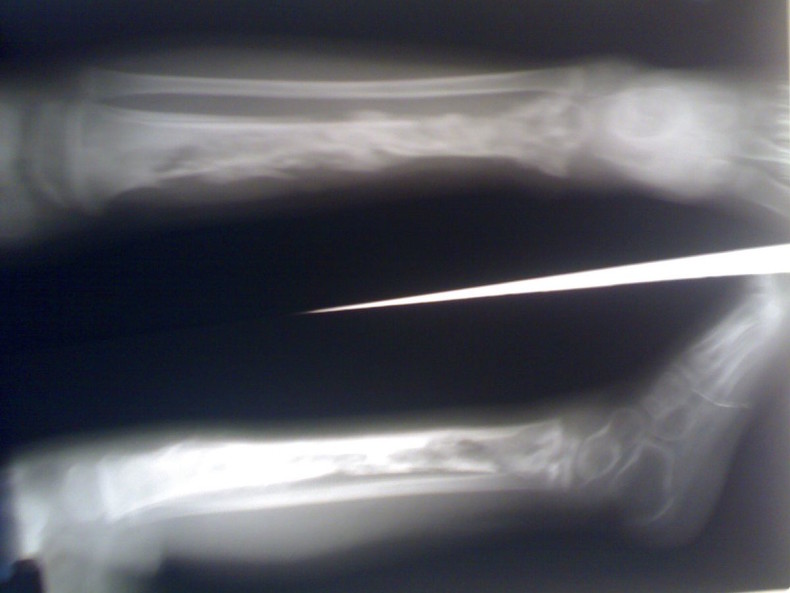
I won’t use her name. How she got the disease no one knows. Her leg was cut off at the knee to stop the infection from spreading, and her name is omitted because she is a respected scientist. What happened in her case verges beyond science.
The disease is osteomyelitis. It means, simply, bone infection. In X-rays, it appears as a haziness, as if the bone were vanishing. An infection can enter the bone through the bloodstream or migrate from nearby tissue. Though it is rare, it is not technically outmoded. It still occurs, but in the case of this story, it should have been outmoded by tens of thousands of years.
This scientist worked with a collection of ancient, infected, horribly malformed dire wolf bones at the Page Museum in Los Angeles. I’ve gone in and looked at the assemblage. The bones constitute a gallery of dark grotesqueries: burls and healed breaks, femurs and skulls that look like swiss cheese or bee hives. It is a disturbing thing to witness, a hall of pain on the shelves where the public doesn’t go.
This sample of extinct Pleistocene wolves all had osteomyelitis. It wasn’t an unusual number, a sample over thousands of years.
What brought her to the collection was the fact that these individuals had died in the La Brea tar pits, and had not died of the disease. Their remains had been encased and saturated in a sticky, oily soup since the Ice Age. Many of the injuries were so extensive, she concluded the wolves could not have survived on their own. Yet outside of the tar pits, they appear to have been healthy in every other way. The tar killed them, not the bone disease. From this she concluded that dire wolves must have lived in packs, which would have allowed the injured to heal and survive.
In this collection of horrors, she found evidence of generosity, wolves helping each other. Food had been brought to them, seeing them through physically debilitating times. Many of the injuries had been allowed to heal, although in twisted and odious ways. They were well enough to scavenge, climbing onto mammoths or camels mired in tar, where they became mired themselves, and eventually perished.
She called me during her research to say that she was starting to feel the pain of the specimens she was studying. She couldn’t help imagining their exposed and infected bone spurs. Animals had suffered long ago, and she could sense it. She dreamed she looked down and instead of seeing her feet, she saw paws treading the earth.
Then she got the disease.
Osteomyelitis entered through her foot. Her bones were quickly riddled with holes that surfaced through her flesh.
She is a bone woman, that’s what I call her. She once asked if she could have mine after I died. She said she liked the shape of my forearms and my skull. When she looked at people or animals, she didn’t just see us from the outside. She could make out our joints and sockets, the spindles of our fingers, the rise of our cheekbones. The rest of what we are is little more than an animated cloak. The real beauty is inside.
Her study of osteology is impressively thorough; she keeps boxes and bins of skeletons of all sorts of animals. When an animal passes at the zoo, she is called in to take what is left. We once defleshed a baboon together, up to our elbows in gore at a stainless steel table. When we got down to the primate’s framework, she touched it almost fondly, admiring the curves and long, sweet lines.
When she got the disease, it moved swiftly inside of her, from foot to tibia. She said it could not have come from the collection. The bones and their diseases were long dead, cooked for thousands of years in hot, thick tar. She said there was no way, it just couldn’t happen.
The amputation was performed as quickly as they could get her in, stopping the infection from traveling farther and killing her. The next morning, after part of her leg had been removed, a mutual friend who runs a museum bone casting business, called her and asked if she’d been able to keep the foot. Disappointedly, she said no. The hospital had incinerated it. A perfect specimen was gone.
She now moves on her prosthetic leg with ease, sometimes with a cane. She painted a wolf onto the fake leg and is proud of it. I don’t ask her anymore where the disease came from, or about her dreams before she got it. This is X-Files stuff, and she is a scientist.
Image: distributed under a CC BY-SA 3.0 license.
Wow, I´ve read this amazed, the wolves research and learning about their desease and behavior, the disease in her. I could comprehend when you said that she found beauty when she was working in the baboon’s corpse, I think that her story let the reader explore an unusual point of view to admire nature, an to put our selves in the same level, right? wolves, human, baboon.